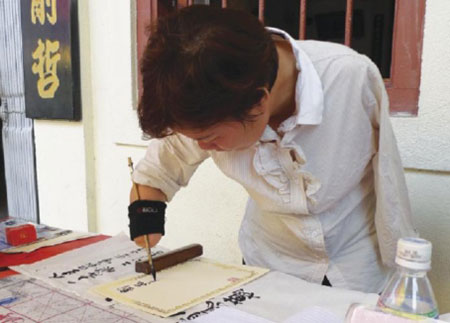Calligrapher's poetry in motion
After becoming disabled at 19, Hoe Xue Mei spent 10 long years to master the incredibly difficult art of Chinese calligraphy.
 Hoe Xue Mei has turned the story of her life from tragedy to triumph
Hoe Xue Mei has turned the story of her life from tragedy to triumphWEEKENDS in Malacca's Jonker Walk can be quite a challenge. Thousands of tourists from other states such as Singapore pack the narrow street and jostle one another for space as cars whiz past.
When she was 19 years old, Hoe worked at a factory. She said she was often tired because she also had to cope with her studies and household chores.
And, one fateful day, her attention lapsed and her arms were crushed by a machine and had to be amputated.
Years later, in a bid to turn tragedy to triumph, Hoe started studying the art of Chinese calligraphy. As a result of 10 years of determination and perseverance, Hoe made great strides in her chosen field.
Very few people ever succeed in mastering Chinese calligraphy, because at higher levels, it has to do with mental control, breathing and some degree of internal energy. So, for a disabled woman like Hoe, it's a truly amazing achievement.
The art of Chinese calligraphy goes back to 4000 BC. Experts have described it as «energy in motion».
The main components, it seems, are time and rhythm. These elements, when employed by a master calligrapher on silk or paper, result in wondrous works of art.
There are numerous calligraphic styles with timelines that stretch all the way back to ancient imperial China. Some examples of these styles are lishu, kaishu, xingshu and caoshu.
Hoe Xue Mei said she had been operating at the site for about three years. The portion of her right arm below the elbow was missing and her left arm was hidden within a long sleeve. But with a traditional writing tool, black ink and a mind as calm as a still pond on a moonless night, Hoe produced the most beautiful pieces of Chinese calligraphy. Some like her calligraphy poems to be based on her love life. Others prefer career-oriented or success-inclined poems.
Source: New Straits Times